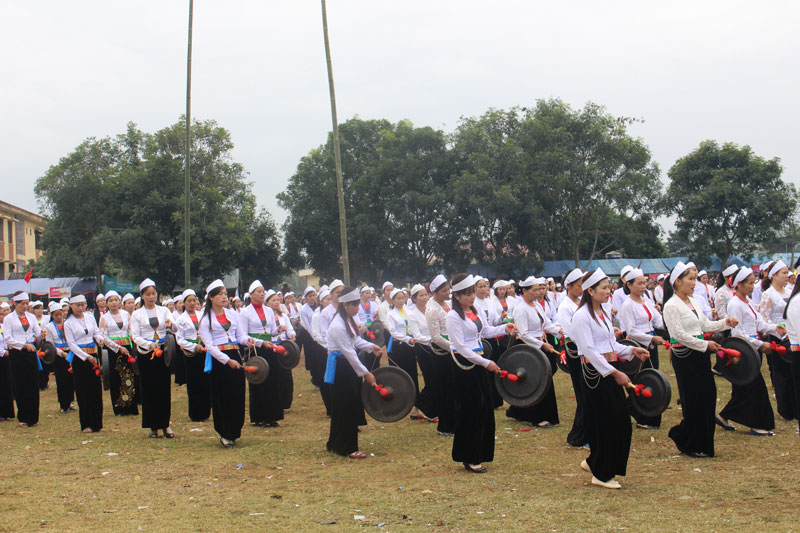


 Gong performance at Khai Ha
Festival in Muong Bi, Tan Lac.
Gong performance at Khai Ha
Festival in Muong Bi, Tan Lac.
There are 6 main ethnic groups living together in the province. Each ethnic group expresses their private and unique cultural identity, creating a diverse, rich, unique and attractive culture ... In which, ethnic Muong people dominate the majority and they live in low-lying areas. The richest centers of Muong ethnic people are: Muong Bi, Muong Vang, Muong Thang, and Muong Dong. In the cultural life, Muong ethnic people still retain many traditional elements imbued with the national cultural identity. Many cultural and artistic values of Muong ethnic group such as folk songs, gongs, Mo, the epic Laying Land – Laying Water ... are still preserved and highly appreciated. The majority of ethnic groups still retain their basic features in their national customs and beliefs, conserving and preserving the heritage values of literature, arts, languages and scripts (except for Muong ethnic groups), folk knowledge, costumes and so on.
Mr. Luu Huy Linh, the Deputy Director of the Department of Culture, Sports and Tourism, says: Over the past years, with the attention of the leaders of the province and the Ministry of Culture, Sports and Tourism and the efforts of all levels, the local authorities have built the cultural action plans and programs, the conservation and promotion of the intangible cultural heritage values have been invested. The achieved results include one traditional cultural village, dozens of the cultural community tourism villages at the provincial level, nearly 30 scientific topics on culture and ethnicity have been carried out. They have invested in nearly 50 classes of folk art transmission and hundreds of ethnic minority literacy classes, 59 festivals have been restored and maintained. In particular, the Department of Culture, Sports and Tourism has advised the Provincial People's Committee to request the Ministry of Culture, Sports and Tourism to recognize 2 intangible cultural heritages, Mo Muong Hoa Binh, the art of Muong Gong - Hoa Binh, as the national intangible cultural heritage. Currently, Mo Muong and the art of Muong Gong - Hoa Binh have been recognized as the national intangible cultural heritage by the Ministry of Culture, Sports and Tourism. Particularly, the Deputy Prime Minister has assigned the Ministry of Culture, Sports and Tourism to coordinate with the relating ministries, branches and localities to make a dossier the intangible cultural heritage of Mo Muong – Hoa Binh and submit it to UNESCO for the recognition as a typical intangible cultural heritage that is in need of urgent protection
Also according to Mr. Luu Huy Linh, the Deputy Director of the Department of Culture, Sports and Tourism, among the preserved and developed cultural values, Mo Muong, Muong gong, handwriting, folk dance ... have been paid attention to and invested. Currently, the province has established 2 Muong Mo clubs in Tan Lac and Lac Son. There are 18 artisans being conferred the title of the elite artisans, 27 artisans are filing for the consideration and awarding the title of the elite artisans in the field of cultural heritage in phase 3, in which, 1 artist is proposed to confer the title of the People's Artist. They have been building the phonetic script of Muong language and step by step teaching them. In addition, the Department of Culture, Sports and Tourism is also collecting and documenting Keeng dance of Thai ethnic people and Doi calendar of Muong ethnic people to submit to the Ministry of Culture, Sports and Tourism for the recognition of the national intangible cultural heritage.